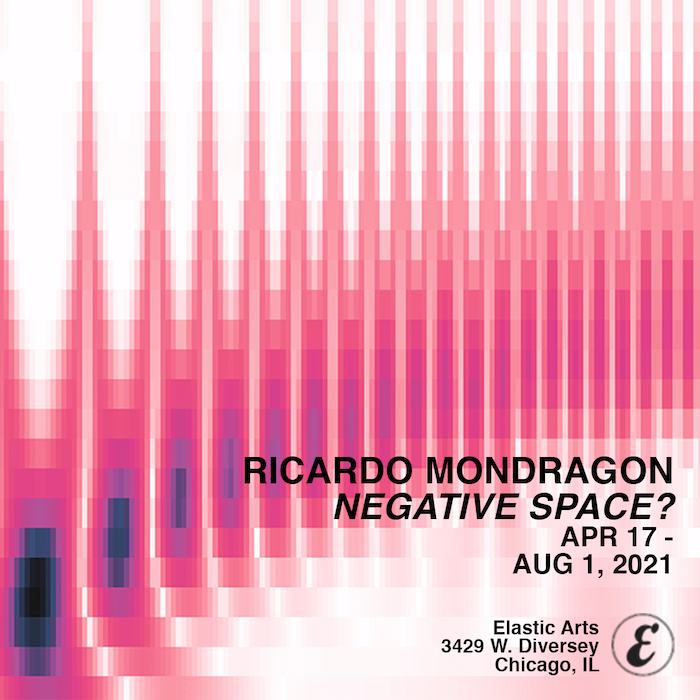Ricardo mondragon
negative space?
april 17, 2021 – august 1, 2021
Curator Essay
Ricardo mondragon - Negative Space?
The work of Mexico City native, Chicago-based artist and music composer Ricardo Mondragon responds to ideas of harmonic content, frequency information, waveform generation, modulation, color, and light to create what he calls “Sound as Visual Art.” Negative Space? presents a series of works that–through a technology-driven process–materialize music, teasing the boundaries between the visual and the aural, making literal the connections in and around space and our ability to connect to systems present in our universe.
Mondragon’s practice stems from an intentional synesthesia of sorts, a desire to fuse harmonic realities that transcend awareness of our lived universe. A classically trained composer, Mondragon found his way to visual art through mathematics after studying the relationship between music composition and geometry. Through a process of analyzing different frequencies with an oscilloscope–a device used to display voltage signals as waveforms over time–Mondragon creates 2- and 3-dimensional representations of harmonies in motion. Waveforms, such as sound-waves, are present in the universe but are part a system of patterns that are not visible to the human eye. We hear them, we may feel them, but we cannot see them outside of their interactions with matter. In order to hear sound, it must pass through an energy source like air, which compresses and displaces the particles back and forth as it travels, (think of a bouncing subwoofer generating bass frequencies through the air, like water rippling outward from a stone’s throw).
We see an example of this in the painting Harmonics (Magenta). The sprawling image, generated by a randomization of frequencies, results in a cascading pattern of vibrating color almost as if the waveforms are coming directly toward you before dropping off into an empty abyss below. In between these distinct sections of color appears to be an absence of information, but in fact this deficiency is not a side effect, it is rather a visual representation of the motion of particles displacing air. It within these “negative spaces” that we see distinct shapes take form, conduits for energy and messages, intuitive to the frequencies at play.
One of the first examples of this phenomena was developed by German physicist Ernest Chladni who discovered this relationship when he applied sand atop a metal plate and ran a violin bow against it, which in turn moved the sand creating complex patterns that would change based on the frequencies being “played.”1 This was an incredible discovery that allowed us to view a snapshot of the invisible universe moving in real time, which is now known as part of a science called Cymatics, the study of visible sound and vibration. Mondragon, influenced by the classic Chladni plate, and using the modern technology of an oscilloscope, takes this a step further by introducing a third axis. Consider that the horizontal axis Y represents voltage and the vertical axis X represents time, the Z axis represents the depth of an object moving front to back in space. Simple waveforms that were once depicted on a flat horizontal axis become visible in 3-dimension. We see this represented in the deftly title sculpture Standing Waveforms, a glass cube composed of what appears to be amorphous cloud-like shapes suspended in time. A Chladni figure in the third dimension becomes visually complex, revealing a strange and beautiful symmetry at work in nature. Hans Jenny, creator of the term Cymatics, resolved that these frequencies are not part of an unregulated chaos, but rather from a dynamic balanced system.2 Over a millennia before his time, ancient philosopher Pythagoras coined the term ‘musica universalis’ to describe his assertion that celestial bodies’ movements were guided by strict harmonious equations, emitting frequencies indiscernible to the human ear.3 So, one can say there are harmonies everywhere and Mondragon uses these ordering structures to embody a visual experience of our unseen universe.
In his painting Old Modulation, Mondragon’s playful approach to negative space is apparent. Waveforms appear thicker, even a bit cartoonish with their exaggerated tooth-like shapes that dance in and away from each other. We see a dialogue between order and chaos, negative and positive energy, a pattern that would infinitely repeat itself if it weren’t for the visual confines of the canvas. In Mondragon’s sculpture Birth we see another pattern of energy frozen in time. Composed solely of triangular waveforms, the chaotic display is the result of a precise arrangement, once again order and chaos in unison. It feels as if we are witnessing the first millisecond of the big bang, a burst of energy restrained inside a 4-inch glass cube, a sculptural biopsy of spacetime. Created by approximately 5 million points and each .65mm apart, the bursting containment is a result of creating negative space inside material, suggesting a fullness of emptiness, a distinction between the way things appear to be and the way they actually are.
Negative Space? allows us to dive into the depths of our awe. Mondragon’s affinity for systems and technology is nourished by a curiosity to look for a deeper order of beauty in nature. The space between and around objects becomes a point of contemplation, like looking up into the infinite night sky, or the periods of silence within a musical piece, negative space is the necessary complement to its positive counterpart, and one cannot exist without the other. Inside these spaces are complex patterns deep-rooted in our ecologies and by shifting our perspective, we can awaken to the harmonies that are in and around us.
-Alyssa Brubaker
Visual Arts Curator
—
1Ernst Florens Friedrich Chladni (30 November 1756 – 3 April 1827) was a German physicist and musician. His most important work, for which he is sometimes labeled the father of acoustics, included research on vibrating plates and the calculation of the speed of sound for different gases. Accessed online: https://en.wikipedia.org/wiki/Ernst_Chladni
2Hans Jenny (16 August 1904 – 23 June 1972) was a Swiss physician and natural scientist who coined the term cymatics to describe acoustic effects of sound wave phenomena. Accessed online: https://en.wikipedia.org/wiki/Hans_Jenny_(cymatics)
3In a theory known as the Harmony of the Spheres, Ionian Greek Philosopher Pythagoras proposed that the Sun, Moon and planets all emit their own unique hum based on their orbital revolution, and that the quality of life on Earth reflects the tenor of celestial sounds which are physically imperceptible to the human ear. Accessed online: https://en.wikipedia.org/wiki/Musica_universalis
4‘Emptiness’ or ‘voidness’ is an expression used in Buddhist thought primarily to mark a distinction between the way things appear to be and the way they actually are. It indicates a distinction between appearance and reality, and thus becomes an expression for the ultimate truth, the final way of things.
Williams, Paul. “The Buddhist concept of emptiness” Routledge Encyclopedia of Philosophy. Accessed online: https://www.rep.routledge.com/articles/thematic/buddhist-concept-of-emptiness/v-1
Related Programming
ST(ART UP) OPENING PARTY
TBD
CLOSING RECEPTION + DJ SET
TBD


















